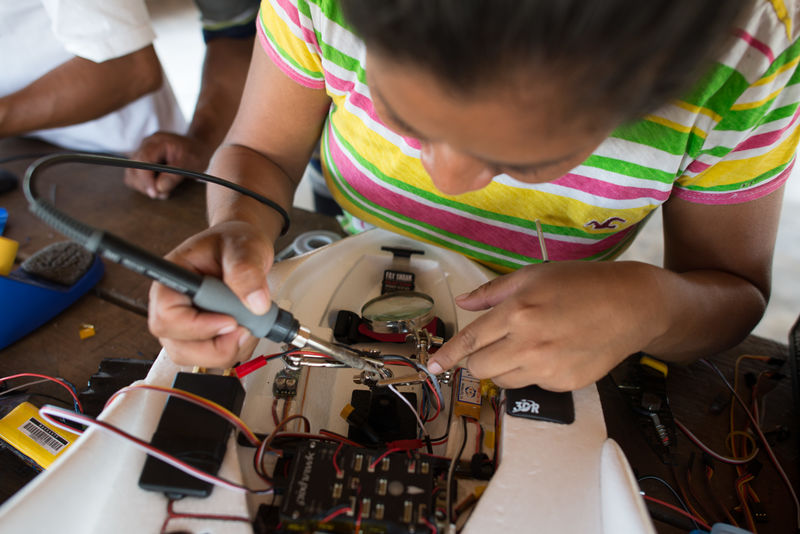- Home
- Braemac Blog
- How to build a Drone - Part 1
How to build a Drone - Part 1
About Cobus Heukelman
Part 1: Communications and antennas
Part 2: Video
Part 3: Navigation
For a drone to fly around your neighborhood, it needs multiple systems working in harmony. Firstly, it needs a flight system to keep it upright and to ensure that each electric motor provides enough thrust for the drone to move in the desired direction. Secondly, it requires a communication system so that the user can tell the drone where to go. Modern drones also have video systems so that the user can control the drone without directly looking at it. To avoid crashes it may need some more sensors and a collision avoidance system. Lastly if you want the drone to be autonomous then it will need a navigation system to plan its route. Even if you’re not designing a drone, your product may still need one of these technologies. Grab your scalpel and forceps, next we’re going to dissect a few of these systems.
Communication System
The communication system is responsible for sending the user’s commands to the drone, and reporting the drone’s state back to the user. If it cannot send commands to the drone quickly enough, the user will experience lag and they won’t be able to control the drone. While the lag and throughput of the communication system are important, it should also be power efficient. Drones use a lot of power to stay in the air so every watt is precious. One last thing to consider is the range of the communication, does the drone need to have a range of 10m, 100m or 1000m?
For simple short range drones up to 100m, Bluetooth Smart is an attractive technology. It has extremely low power consumption, and can easily communicate with an app on smartphones or tablets. Unfortunately their low throughput means streaming video is out of the question. Symmetry offers many different Bluetooth Smart modules such as the Silicon Labs BGM111 and BGM113. These modules have onboard antennas and are CE and FCC certified, making integration a breeze. You can start your design with a module, and when production volumes increase you can take advantage of using the Blue Gecko Bluetooth Smart SoC directly, without having to change your firmware. Nordic also offers Bluetooth Smart SoCs such as the nRF51822 which is now available as a thin WL-CSP variant measuring only 3.83 x 3.83 x 0.35mm and the nRF52832 which supports Bluetooth Smart, Ant and proprietary 2.4GHz protocols with data rates up to 2Mbps.
 Silicon Labs BGM111 (12.9 x 15mm) - BUY NOW!
Silicon Labs BGM111 (12.9 x 15mm) - BUY NOW!
 Silicon Labs BGM113 (9.2 x 15.8mm) - BUY NOW!
Silicon Labs BGM113 (9.2 x 15.8mm) - BUY NOW!
Telit, known for their cellular modules, recently disrupted the Bluetooth market by releasing their own Bluetooth Smart modules. These are based on the Nordic SoC, and offer an attractive alternative for smaller volume customers who want to start with a module and move to the Nordic SoC later.
Telit BlueMod+S42 (17 x 10mm) - BUY NOW!
For longer ranges a module which operates in a lower frequency band, such as the 868MHz or 915MHz bands can be used. The Multitech MultiConnect mDot module offers a range of up to 10 miles in the open and 1 to 3 miles through buildings. The price of extra range is a lower throughput, so these modules give a maximum data rate of 300Kbps. This would be ideal for a surveillance drone which does not communicate constantly. Another scenario where this technology can be useful is for retrieval of a drone that has crashed or is out of power. The low power consumption and long range of these modules means that a lost drone can send its GPS coordinates to the user on an almost empty battery.
Most of the consumer drones today use WiFi for all communication including streaming video. That’s because it’s easy to connect to existing devices such as smartphones and tablets, and supports high data throughput needed for video. The Silicon Labs WGM110 module is great for easy incorporation of WiFi. If you’re building a micro drone and PCB space is constrained, Gainspan’s new GS2200MIZ module can come to the rescue. It has a footprint of only 13.5 by 17.85 mm and onboard antenna. These modules all come pre-certified.
 Silicon Labs WGM110 (14.4 x 21mm) - BUY NOW!
Silicon Labs WGM110 (14.4 x 21mm) - BUY NOW!

Antenna System
To ensure that you can control your drone, and that it can stream its video feed back to the user, it will need a few antennas. It would be nice if these antennas are small and light, so you don’t waste valuable space and battery life. Antenova offers small form factor antennas for all your communication needs. For GNSS, they have SMD antennas such as the Brevis-GNSS which is 11.0 x 6.1 x 3.2 mm, and the high tech Sinica at only 7.0 x 5.8 x 0.4mm. If you’d rather have a cabled antenna, the adhesive mount Bentoni GNSS Antenna is easy to integrate with an IPEX MHF connector. You might be wondering if you could just get one antenna that will take care of both GNSS positioning as well as WiFi, and for that the Asper antenna is a great choice.


For more technical information on how to use these parts, don’t hesitate to contact the friendly engineers at Symmetry.
Up next - Part 2: Video


